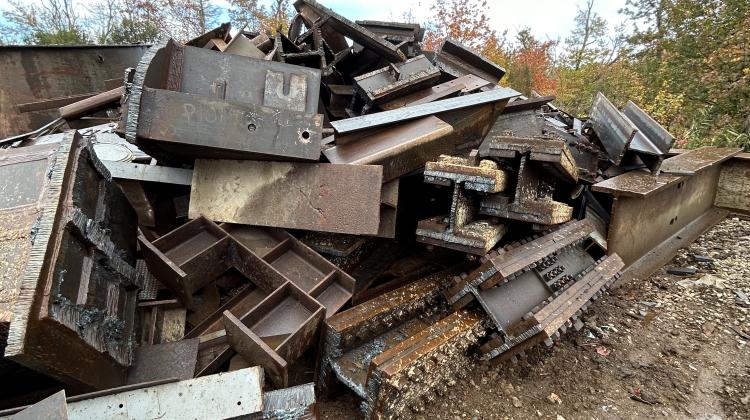MIT awarded federal grant to support clean manufacturing of U.S. steel

Discarded steel beams, shown here as scrap steel mid-preparation to be shipped and melted down. The grant aims to enable the use of this usable structural steel, intercepting it prior to scrap processing. Photo: Juliana Berglund-Brown
Reusing steel will reduce carbon emissions and lower the costs of construction
By Maria Iacobo
John Ochsendorf, the Class of 1942 Professor of Civil and Environmental Engineering and Architecture at MIT, and Juliana Berglund-Brown SM ‘23, a PhD candidate in Building Technology in the Department of Architecture, have been awarded a grant from the U.S. Environmental Protection Agency (EPA) to help measure and mitigate carbon emissions in construction. The approximately $1 million grant over three years is part of a national effort to reduce pollution from the manufacturing of construction materials and products.
The grant will fund research to advance understanding about structural steel products at the end of a building’s life and assess the impacts of reusing steel in new buildings. This work investigates the carbon implications of structural steel reuse, establishing industry collaboration and a reused steel supply chain network for market development while providing regional guidance for publishing the open data needed for robust reused steel Environmental Product Declarations (EPDs).
“Despite the potential carbon and cost benefits, there are still many barriers to adoption of structural steel element reuse, including supply chain dynamics and availability, absence of trust and communication, and lack of reuse markets,” says Ochsendorf. “This project will help to advance and demonstrate the cost-effective carbon reductions for architects, engineers, and planners who reuse steel elements.”
Structural steel element reuse offers significant potential for scalable carbon and social cost mitigation. The EPA estimates that construction materials used in buildings and other structures in the built environment account for more than 15 percent of annual global greenhouse gas emissions. Reusing structural elements in buildings can lower emissions, while reducing negative human impacts and construction costs.
Berglund-Brown says she sees the reuse of structural steel in buildings as a way of applying circular economy principles to the built environment.
“Reusing existing elements is the second most sustainable design option for buildings next to not building at all,” says Berglund-Brown. “As we began this research, it became apparent that steel structural elements had the most potential for widespread adoption by industry for many reasons related to material properties and other characteristics.
“We are deeply motivated by implementation, and by taking action to combat climate change in the construction sector. For that reason, we highly value public and industry partnerships, and want to facilitate further collaboration with this grant.”
Nearly $160 million for 38 grant recipients was awarded by the EPA to support the Federal Buy Clean Initiative, which leverages the U.S. government’s influence as the world’s largest purchaser to drive demand for clean construction materials used in federal buildings, highways, and infrastructure projects.


